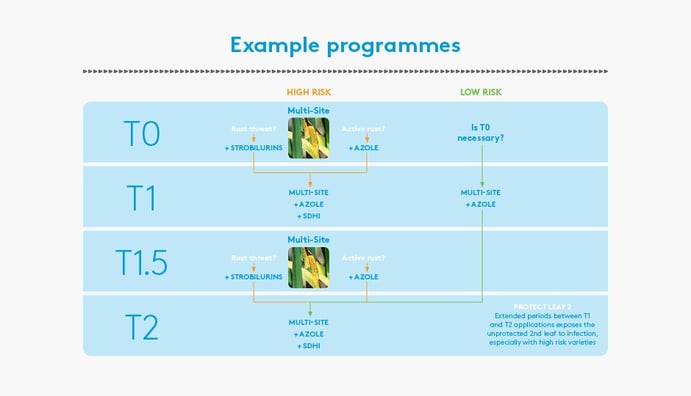2018 - Leaf layering: protecting each new leaf effectively

While the majority of growers and agronomists will try to keep ahead of septoria by laying down crop protection at routine growth stages (T0 to protect Leaf 4, T1 to protect Leaf 3, T2 to protect Leaf 1, and T2 to belatedly protect Leaf 2), these traditional spray timings can leave a key leaf layer unprotected for long periods of time.
For example, if the standard T1-T2 protocol is followed, leaf 2 can be fully emerged and unprotected for as long as 10-14 days before the T2 application is made. This time delay can be even longer if the T2 application is delayed, often resulting in leaves becoming infected and in need of a curative solution.
Because fungicides work better as protective solutions than they do in curative situations, the gap between sprays should therefore to reflect the crop’s development and real-time disease status.
Historically, allowing crops to become infected with septoria during the early stages of plant development wasn’t a problem as the fungicide armoury contained azoles which could effectively eradicate/cure existing infections. Unfortunately, the curative efficacy of many of these fungicides is no longer quite so robust, hence the need to avoid entering a situation where curative activity is required. SDHIs do still provide some curative activity, but we, as an industry, need to protect this mode of action against unnecessary erosion – this can be best achieved by providing crops with adequate protection, rather than relying on the need for curative activity.
This situation can be avoided by protecting the newly emerged Leaf 2 at a T1.5 timing – a none routine spray typically reserved for seasons where the T1/T2 gap is stretched due to crop development.
Growers should therefore consider the concept of ‘Leaf Layering’ to ensure optimum leaf coverage and protection during the ‘at risk’ period. Applying a T1.5 application (first choice should be a multi-site to provide contact protection against septoria, potentially mixed with a strobilurin to protect against the threat of rust, or an azole/morpholine if active rust is present) will fill the gap between the traditional T1 and T2 applications, and will ensure each new leaf is properly protected from infection, thus providing effective disease prevention and negating the need to rely on curative activity.

*NB: Please seek advice from a BASIS qualified agronomist to ensure your crop protection programme is fully compliant and appropriate for your crop’s current status.
Growers should also be mindful of the need to use the correct nozzle at each application and to ensure that adequate water volume is used: improving working rates by spraying with lower water volumes than are recommended on the product labels will be counter-productive if the reduced water volume jeopardises leaf coverage. In particular, consider which products are being applied. For example, when applying contact/protectant fungicides to cereals at key timings in the spring, it is important to consider that such fungicides rely on good leaf coverage to work at their optimum efficiency and efficacy. Therefore, reducing the water volume below 100L/ha could compromise product performance.
More information on the correct usage, storage and disposal of plant protection products can be found here: http://www.hse.gov.uk/pesticides/topics/using-pesticides.htm
For more information about correct nozzle selection, click on the link below: AHDB nozzle selection chart: https://cereals.ahdb.org.uk/media/179976/p05-nozzle-selection-chart-2010-2014-reprint-.pdf
 United Kingdom
United Kingdom Select country
Select country




